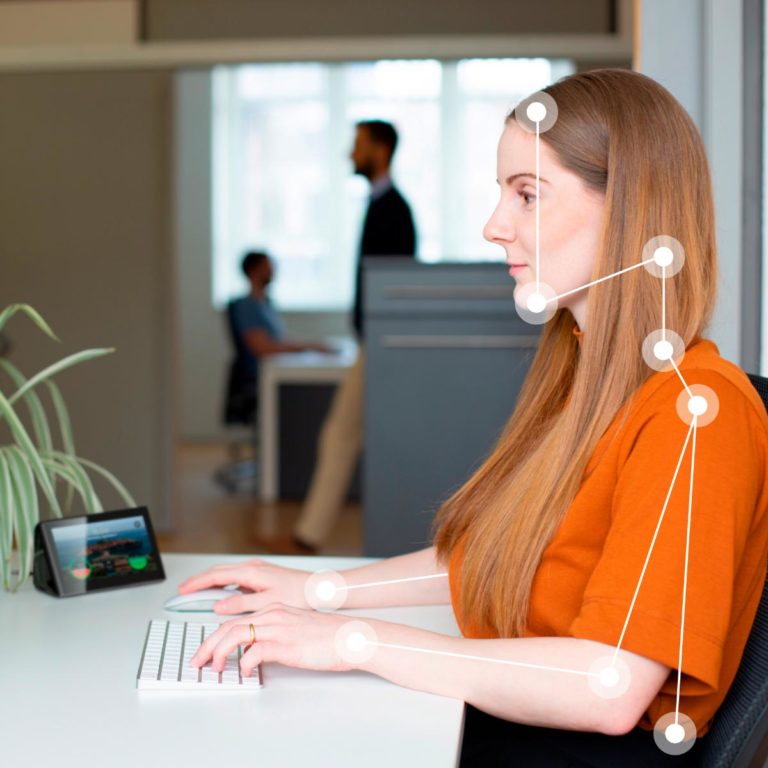
Over a period of 6 to 12 weeks, «Isa – ergo move» reflects unhealthy behaviors and teaches valuable skills for a sustainably healthier way of working in the office and home office.
Isa identifies and addresses individual health risks of your team and contributes to a culture of movement and ergonomics in the long term.
With Isa, you create a health offer that also appeals to those who normally stay away from company health promotion measures.
Isa arouses curiosity and enables flexible and completely effortless use directly at the workplace.


Improved ergonomics
more movement
develop habits
"Really motivates me to move more and effectively reminds me that I should drink more often. I like Isa :-)"
"Should become the standard for office jobs."
"It works really well to motivate yourself to take a short break for exercise, even in phases of concentration. Helps with thinking;)"

You advertise the offers (that's all you have to do)
Customised & sustainable! Through several weeks of behaviour-based coaching.
With high reach! As a digital product, Isa is cost-effective and scalable.
Simple, without effort! We take care of the onboarding, the logistics and accompany the entire process from start to finish.

The decisive factor for effectiveness is that the application is actually used. This is where many digital approaches fail. Isa is different...
Always present: Isa simply runs alongside without you having to pick up your smartphone first.
Plug and Play: Put it down, switch it on, it runs. No initialisation effort.
Focus on health: Isa does not mix with work content on the PC or private distractions of the smartphone.
Precise detection: The highly accurate sensor enables a competent assessment of health behaviour.
Individual: Based on the actual health burden, Isa can provide holistic and competent guidance.
Data security: Due to the closed system, there are no security gaps.
Please let the following questions run through your mind:
If your smartphone is on your desk all day and a health app is continuously communicating with you, would you let private apps distract you from work?
Do you agree that your smartphone or webcam on your PC (both connected to the internet) is watching you via camera throughout your working day?
What do you think about more pop-ups on your PC while you work?
A high dependence on smartphones has been proven to have a negative impact on mental and physical health as well as cognitive performance. Doesn't a health app that motivates you to continuously use your smartphone therefore represent a contradiction?
These classical approaches are important to sensitise and train employees for health in the workplace. However, they are only selective measures that take place outside the working day. As a result, they have limited impact on people's behaviour during their long hours in the office.
In contrast, Isa accompanies employees over a longer period of time and is constantly available to contribute individually to healthy behaviour. This tackles the problem from the ground up. On the one hand, Isa helps to prevent health risks from the very beginning. On the other hand, the long-term accompaniment enables employees to develop and consolidate new healthy behaviours
Absolutely! It is one of the core functionalities of Isa to guarantee the optimal use of a height-adjustable desk. This feature can be easily switched on or off in Isa's settings, depending on the availability of a height-adjustable desk.
Yes, we work with various health insurance companies that use Isa as part of their prevention and health promotion services in accordance with §20 SGB V in companies. However, this only takes place after individual consultation with the respective health insurance companies.
We attach great importance to you being able to work in the best possible way! The Isa's interaction concept is very discreet, intuitive and can be adjusted individually. However, if Isa detects a major health burden during your work, you will be interrupted from time to time. However, this is done for the good of your health and thus serves your long-term performance.
No. The sensor only creates an anonymous 3D silhouette of the person at the desk. This does not make it possible to identify people.
Isa ensures that you still feel good after a long day at work. In addition, Isa helps you prevent musculoskeletal disorders (e.g. back pain) and serious long-term diseases such as diabetes.
Enough to experience a noticeable health benefit. On the other hand, not so many that you are distracted from your work. Most importantly, Isa adapts to your personal habits and fades further and further into the background with healthy behaviour.
Of course. You benefit from constant new functions and programmes that are made available to you.
Yes. All functions can be switched on and off or set individually.
No, Isa is not a medical device.
Behavioural prevention refers to measures of occupational health managementwhich aim to reduce the risk of illness through individual behavioural changes. In contrast to relationship prevention, which deals with external conditions and structures, behavioural prevention focuses on the behaviour of individuals. Health-conscious behaviour plays a crucial role in the prevention of illness, as many risk factors such as poor ergonomics, unhealthy diet, lack of stress management and low fluid intake are based on behaviour. Health behaviour can be supported by various measures, including preventive medical measures tailored to the individual risk, as well as the creation of health-promoting working conditions and ergonomics.
Behavioural prevention measures can be: Exercise, ergonomics coaching, nutritional counselling, health days, fitness or "Isa - ergo move".
Behavioural prevention is important in order to avoid mental and physical stress and promote health. The behavioural prevention approach concentrates on behaviour, while situational prevention focuses on living conditions and circumstances. Behavioural prevention measures, such as creating health-promoting living environments or using prevention services offered by health insurance companies, are crucial for maintaining a health-conscious lifestyle. By promoting health literacy and avoiding health risks such as smoking, lack of exercise, poor ergonomics or an unhealthy diet, illnesses can be recognised at an early stage and combated preventively.
Promoting health-conscious behaviour can lead to an enormous reduction in sick days. Employees are currently off sick for an average of 20 days, which not only costs companies money, but also exposes other employees to unnecessary mental stress. This needs to be tackled.